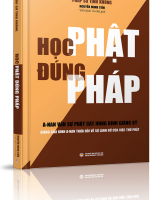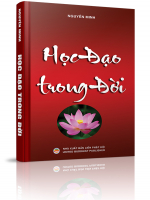Hãy cống hiến cho cuộc đời những gì tốt nhất bạn có và điều tốt nhất sẽ đến với bạn. (Give the world the best you have, and the best will come to you. )Madeline Bridge
Ai sống quán bất tịnh, khéo hộ trì các căn, ăn uống có tiết độ, có lòng tin, tinh cần, ma không uy hiếp được, như núi đá, trước gió.Kinh Pháp cú (Kệ số 8)
Người biết xấu hổ thì mới làm được điều lành. Kẻ không biết xấu hổ chẳng khác chi loài cầm thú.Kinh Lời dạy cuối cùng
Con tôi, tài sản tôi; người ngu sinh ưu não. Tự ta ta không có, con đâu tài sản đâu?Kinh Pháp Cú (Kệ số 62)
Ý dẫn đầu các pháp, ý làm chủ, ý tạo; nếu với ý ô nhiễm, nói lên hay hành động, khổ não bước theo sau, như xe, chân vật kéo.Kinh Pháp Cú (Kệ số 1)
Hãy học cách vui thích với những gì bạn có trong khi theo đuổi tất cả những gì bạn muốn. (Learn how to be happy with what you have while you pursue all that you want. )Jim Rohn
Yếu tố của thành công là cho dù đi từ thất bại này sang thất bại khác vẫn không đánh mất sự nhiệt tình. (Success consists of going from failure to failure without loss of enthusiasm.)Winston Churchill
Chỉ có cuộc sống vì người khác mới là đáng sống. (Only a life lived for others is a life worthwhile. )Albert Einstein
Ngay cả khi ta không tin có thế giới nào khác, không có sự tưởng thưởng hay trừng phạt trong tương lai đối với những hành động tốt hoặc xấu, ta vẫn có thể sống hạnh phúc bằng cách không để mình rơi vào sự thù hận, ác ý và lo lắng. (Even if (one believes) there is no other world, no future reward for good actions or punishment for evil ones, still in this very life one can live happily, by keeping oneself free from hatred, ill will, and anxiety.)Lời Phật dạy (Kinh Kesamutti)
Đừng than khóc khi sự việc kết thúc, hãy mỉm cười vì sự việc đã xảy ra. (Don’t cry because it’s over, smile because it happened. )Dr. Seuss
Mục đích của đời sống là khám phá tài năng của bạn, công việc của một đời là phát triển tài năng, và ý nghĩa của cuộc đời là cống hiến tài năng ấy. (The purpose of life is to discover your gift. The work of life is to develop it. The meaning of life is to give your gift away.)David S. Viscott
Trang chủ »» Danh mục »» TỦ SÁCH RỘNG MỞ TÂM HỒN »» Dependent Arising »» Different points of view in Tibetan Buddhism »»
Dependent Arising
»» Different points of view in Tibetan Buddhism
 Xem Mục lục
Xem Mục lục 
- Introduction
- Dependent Arising
- The Drawing of the Wheel of Cyclic Existence
- The Twelve Links of Dependent Arising
- Explaining the Twelve Members in Terms of More than One Round
- Other Aspects of Dependent Arising
- Dependent Arising and Training the Mind
- Overcoming Afflictive Emotions
- Generating the Bodhisattva's Altruistic Attitude
- Practice of the Six Perfections
- Tantric Practice
- »» Different points of view in Tibetan Buddhism
- none

In Highest Yoga Tantra the term view is used predominantly in the context of that which views, the subject that views. Although there is no difference with respect to the emptiness that is viewed, there is a difference in the consciousness, the subject that views that emptiness. It is in this context that Sa-kya Pandita says that Sutra and Mantra have the same view. There are also many similar statements in Ge-Iug. The reference is to the object that is viewed, emptiness.
There is no difference between the emptiness of Sutra and the emptiness of Mantra. However, in Sa-kya again it is said that there are four different views of the four initiations in Highest Yoga Tantra. Similarly in Ge-Iug, there is reference to the view of the undifferentiable bliss and wisdom. In such cases the reference is not to the object that is viewed but to the subject that views: the consciousness that is viewing emptiness. There is a difference here, even if there is no difference in terms of the object that is viewed. In Ka-gyu and Nying-ma it is also said that the view of Mantra is superior to that of Sutra. All of them are referring to a distinctive, more subtle type of consciousness that is viewing.
Now in Sa-kya, there is a presentation of the undifferentiability of cyclic existence and nirvana. It is said that one is to settle the question of the undifferentiability of cyclic existence and nirvana in terms of the causal continuum of the basis of all. There are differences of explanation among the Indian pandits and also small differences of explanation within Sa-kya, but this causal continuum which is the basis of all refers to the reality of the mind. In the Guhyasamaja Tantra there are explanations of students of varying capacity. The supreme is the jewel-like person. He or she could be described as the causal continuum which is the basis of all. In the Sa-kya's own system the causal continuum which is the basis of all is identified by Mang-to Lhun-drup Gya-tso, a great scholar, as being the fundamental innate mind of clear light.
In another Sa-kya system it is identified as all the impure aggregates, constituents etc., of a person. It is said that in the causal continuum which is the basis of all, all phenomena of cyclic existence are complete in their characteristics. All the phenomena of the path are complete as high qualities. All the phenomena of Buddhahood are complete in the manner of effects.
With regard to the equality of cyclic existence and Nirvana, in the Sutra system as Nagarjuna said, 'Cyclic existence and nirvana, do not inherently exist: A consciousness that is realizing the emptiness of inherent existence of a sprout and a consciousness that is realizing the emptiness of inherent existence of a divine body are similar. Likewise when one has understood the meaning of the non-inherent existence of cyclic existence and all true sufferings and sources of suffering have been extinguished, the reality into which they have been extinguished is nirvana. This is the Sutra system. Now, the reference in the Sa-kya presentation to the equality of cyclic existence and nirvana is to viewing the impure mental and physical aggregates and so forth as primordially existing as pure mental and physical aggregates, constituents, and so forth. According to the thought of the great scholar Lhun-drup Gya-tso, one views all of the phenomena of cyclic existence and nirvana as the sport or reflection of the fundamental innate mind of clear light. Thus, what we were getting down to here is the fundamental innate mind of clear light.
In the Ka-gyu system there is the practice of the four yogas. The first is one -pointedness of mind, the second, that which is devoid of conceptual and dualistic elaborations. These two are said to be common with the Sutra system. In the first, one is mainly achieving a calm abiding of the mind With the state of being devoid of elaborations one is mainly achieving special insight, realizing emptiness. The third, the yoga of one taste, can be considered as an advanced or enhanced type of special insight in which all phenomena of cyclic existence and nirvana have the single taste of the fundamental innate mind of clear light. This brings once again to the mind of clear light and Highest Yoga Tantra. When one advances in this prac-tice, one arrives at the fourth yoga, the yoga of non-meditation. As Nagarjuna says in his Five Stages, which presents the path of Guhyasamaja, 'When one arrives at the stage of union, there is no new path to be learned'. The thought here is the same as the yoga of non-meditation.
We have to make a difference between mind and basic mind (sems and sems-nyid), between mind and mindness. Mindness or basic mind is the innate truth body, the fundamental innate mind of clear light. Whether appearances are pure or impure, all of them are like waves of the Truth Body, they appear from the sphere of the Truth Body. This last point relates to the Mahamudra of the Ka-gyu.
Then, with regard to the Ge-lug, if you ask whether the views that were just presented accord with the Madhyamika view in general - they do not. But you could say they accord with the special Madhyamika view of Highest Yoga Tantra, which is concerned with the innate union of bliss and emptiness. On that level, they are the same. In Ge-lug teachings, in their Sutra teachings and even Tantra teachings, there is great emphasis on the view as being the object of the view, that which is viewed, the emptiness that is viewed. However, in Ge-lug there is also a description of this difference in view in terms of the subject. For it is said that all pure and impure phenomena of cyclic existence and nirvana, as well as being the sport of emptiness (the object), are also to be viewed as the sport of the subject, the viewing consciousness the innate mind of undifferentiable bliss and emptiness. As Nagarjuna says in his Five Stages, 'The yogi himself or .herself abides in the meditative stabilization which is like illusion, and similarly views all phenomena the same way, as being the sport of this basic innate mind of undifferentiable bliss and emptiness.
With respect to Dzog-chen, the view of the Great Completeness, the mode of explanation is very different, but it is getting at exactly the same thing. As my source for this I mainly rely on Dodrup-chen, Jig-me Ten-pai Nyi-ma a really great scholar, as well as great practitioner; a really remarkable yogi. In the Great Com-pleteness, the reference is to the fundamental mind of clear light, but the vocabulary used is that of ordinary consciousness. It is necessary to make a difference between sems and rig-pa or between mind and basic knowledge.
In the Nying-ma system, Highest Yoga Tantra is divided into three categories, Maha, Anu and Ati yoga. Ati yoga itself is divided into three classes; the class of mind, the class of the great vastness and the class of quintessential instructions. As the great Do-drup-chen says, 'All practitioners of Highest Yoga Tantra in the New and Old translation schools are practising just the fundamental innate mind of clear light:
The difference is that in the other systems, in the initial stages of practice, there are many paths that use conceptuality to advance to this other stage. Whereas in the Great Completeness, the practitioner relies on the quintessential instructions, right from the outset, without seeking help from conceptuality, right from the beginning, the emphasis is on the basic knowledge.
One puts the emphasis on the basic mind right from the beginning. Thus, it is called the doctrine that is free from exertion.
Because there is tremendous emphasis in the Great Completeness system on the fundamental innate mind of clear light, an uncommon presentation of the two truths. These are called the special two truths. This could be roughly expressed thus, that which is fundamental and innate is the ultimate truth, and anything relative to that is adventitious, is a conventional truth. From this point of view, the fundamental innate mind of clear light is empty of all conventional truths, of adventitious phenomena, thus it is an other-emptiness, an emptiness of the other. However, this fundamental innate mind of clear light is said to have a nature of essential purity, thus it does not pass beyond the nature of the emptiness of inherent existence that is set forth in the middle wheel of Buddhist teaching.
Because this other-emptiness is set forth in the context of compatibility with the emptiness of inherent existence of the middle wheel of the teaching as in Madhyamika, some scholars have called this a good other-emptiness. Whereas they have called a teaching of Buddha nature, or maybe the fundamental mind of clear light, in which one looks down on the middle wheel of teachings and advocates that the fundamental mind of clear light does inherently exist, a bad other-emptiness. Many scholars from all the schools of Tibetan Buddhism, Nying-ma, Ka-gyu, Sa-kya, Ge-lug, have specifically refuted the presentation of some sort of final truth that is itself inherently existent. They have refuted a presentation that looks on the emptiness of inherent existence that is taught in the Madhyamika system as a sort of lower teaching, calling it a self-emptiness that is to be looked down upon. That sort of teaching is unsuitable.
The oral transmission from the great adept Dzong-sar Khyentze Cho-kyi Lo-dro says that the presentations of the levels of the path in the Nying-ma system are seen from the perspective of a Buddha. Whereas in the Sa-kya system the presentation of the path is mainly in terms of the spiritual experience of a yogi on the path. The presentations in the Ge-lug system are mainly from the perspective of ordinary sentient beings. This is important to consider, it can help you overcome a lot of misunderstandings. In his writings, Je Tsong-kha-pa raises many qualms and investigates and eliminates them with respect to the mode of perception of a Buddha. He went into a lot of analysis about how a Buddha sees the various types of phenomena, classed as pure and impure.
While on the path, to create an imprint of putting emphasis on both the wind and the mind with respect to the mode of achieving Buddhahood, one develops a pure illusory body together with the mind of clear light. Now I mentioned earlier a system that emphasizes just the mind. In the Kalachakra system, in dependence upon achieving a union of a body which is empty form and immutable bliss, Buddhahood is achieved. Then there is another, third mode, a rainbow body, which is the exclusive mode of procedure of the Mother Tantras. In the Nying-ma system of the Great Completeness, in dependence upon bringing to completion the four appearances, all of the coarse factors of one's body are consumed, much as in the system of achieving Buddhahood by way of the great transference of a rainbow body.
From CHÖ YANG The Voice of Tibetan Religion and Culture No.3
Editor: Pedron Yeshi
Co-editor: Jeremy Russell
MUA THỈNH KINH SÁCH PHẬT HỌC
DO NXB LIÊN PHẬT HỘI PHÁT HÀNH
Mua sách qua Amazon sẽ được gửi đến tận nhà - trên toàn nước Mỹ, Canada, Âu châu và Úc châu.
Quý vị đang truy cập từ IP 216.73.216.60 và chưa ghi danh hoặc đăng nhập trên máy tính này. Nếu là thành viên, quý vị chỉ cần đăng nhập một lần duy nhất trên thiết bị truy cập, bằng email và mật khẩu đã chọn.
Chúng tôi khuyến khích việc ghi danh thành viên ,để thuận tiện trong việc chia sẻ thông tin, chia sẻ kinh nghiệm sống giữa các thành viên, đồng thời quý vị cũng sẽ nhận được sự hỗ trợ kỹ thuật từ Ban Quản Trị trong quá trình sử dụng website này.
Việc ghi danh là hoàn toàn miễn phí và tự nguyện.
Ghi danh hoặc đăng nhập
... ...


 Trang chủ
Trang chủ







